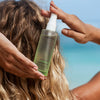Have you ever thought about the ugly effect your beauty products have on the environment?
The £360+ billion per year global personal care industry is booming, and with it, the amount of plastic contributed to our planet’s waste. From the mascara wands and brushes we use to the bottled lotions and creams that line our night stands, our personal care and cosmetics are generally made using, or at least come housed in, a plethora of plastic and packaging.
Have a scan of your shelves now and count how many tubs, pots, tubes and bottles you can see… more than at least three? We know, it’s hard to escape the hard stuff when it comes to packaging such products! So let’s educate ourselves a little.
What is plastic?
Plastic is a synthetic material typically made from the chemicals derived from fossil fuel production. This means that its production is linked to the use of gas, oil and even coal – all of which play a huge part in the warming of our planet. So, while the containers that our personal care items arrive in help to keep them fresh for optimum use, they’re a little less optimal for our oceans and environment.
How do we process plastic?
Its manufacturing and transportation are carbon intensive, and there are only three primary ways of processing it. These include recycling, landfill and incineration.
What impact can incineration have?
The disposal of plastic via incineration causes the release of CO2 and toxic dioxin emissions into the environment. The latter can cause cancer and brain damage, as well as being harmful to many of the body’s regulatory systems, so we think it goes without saying that this is one method we’d all be a little better off without resorting to.
What impact can landfill have?

As many plastics contain additives which make them stronger, more flexible, more durable and ultimately harder to break down, the plastic that ends up in landfill is largely there to stay. In fact, it can take centuries for a single plastic item to fully break down, meaning that plastic landfill has led to the ever-growing problem of accumulating, non-degradable waste.
And yet, while recycling is by far the best means of processing plastic (for the environment as well as for our own health), a study published in the peer-reviewed journal Science Advances found that of the 8.3 billion metric tons of plastic that have been produced, 6.3 billion metric tons have become plastic waste.
This means that “the vast majority (of plastic waste) – 79 per cent – is accumulating in landfills or sloughing off in the natural environment as litter...”
What happens when plastic pollutes our natural environment?
While plastic cups floating down rivers might be easy to see and remove, the existence of microplastics make plastic pollution a much harder problem to solve.
Microplastics constitute plastic particles that are smaller than five millimetres in diameter. Most microplastics pass through our water filtering systems and end up in our oceans (a devastating eight million tonnes per year, in fact), before subsequently being consumed by our fish, birds, marine life, and in turn, us.
How does the beauty industry contribute to this plastic pollution?
In a report carried out by Zero Waste, it was found that more than 120 billion units of packaging are produced each year by the global cosmetics industry, and much of this is not recyclable.
From the bottles that house our shampoos and lotions, to the tubes that contain our natural serums and creams, the majority of beauty products we purchase as an everyday consumer come packaged in plastic. Hard as we may try, if we’re not careful and deliberate with our beauty choices, we merely become part of the problem.
Our Refillable Makeup

As part of our ongoing promise to help create a healthier, greener, more empowered world, we’re constantly striving for ways to be a force for good beyond beauty.
That’s why we created our complete Colour Palette; a compact, portable, customisable makeup tray that streamlines getting ready while protecting the planet. Being infinitely refillable and made using completely recyclable trays and pans, it helps you save money and reduce your packaging use simultaneously – the planet and our complexions will be glowing!
You’ll never need to acquire new, excess containers for your makeup again – simply select which blusher, bronzer, highlighter, contourer, concealer, eyeshadow, brow shade, eye liner, lipstick or setting powder you need replacing and refill your original Colour Palette ad infinitum!
With its millions of customisable combinations to choose from, our Colour Palette has stopped 12.5 tonnes of plastic waste from being generated when compared to our previous makeup range, a figure we’re incredibly proud of and excited to see continue to climb!
And it’s not just our Colour Palette that’s refillable! We also offer refillable options on our Setting Powder and Mineral Foundation – and don’t forget that some of our skincare range (such as our nourishing, balmy saviour Lip Love) is made using post-consumer recycled packaging, meaning its packaging has already lived at least one life before!
How can you help?

But that doesn’t need to be the case! There are a multitude of steps we can take to minimise our contribution to plastic pollution:
Keep an eye out for certain labels on the packaging. They’ll help clarify such things as whether or not a product has been sustainably sourced, and might include verification from the likes of Rainforest Alliance Certified and ECOCERT.
Replace short life cycle items such as makeup/wet wipes with longer use, natural options.
Our own Bamboo Face Cloth is a natural, antibacterial option that’s made from a mix of sustainable bamboo and cotton fibres, to ensure it’s as kind to the environment as it is to the complexion.
What’s more, if you wash it around twice a week and ring it out to dry in a well-ventilated area, it should be reusable for up to three months – much longer than your single use wet-wipes!
And then, just when you think you’ve eeked every last face cleanse and gentle exfoliation from it, it’s time to give it a new lease of life:
The uniquely soft fibres in the cloths make them the perfect non-abrasive apparatus for gently dusting your softwoods and surfaces, so when the cloth is done with your face, let it give your home a little spruce!
And finally, if you cut your Bamboo Face Cloth into eight inch by four inch strips and entwine these strips in sections of your dampened hair – before pinning it up into a hair net or hat before bed – you’ll arise the next day with wonderfully curled locks.
Cleanser, duster, and now curler? What more could you want?
Choose products in reusable, recyclable packaging and take advantage of refill schemes.
Recyclable items help prevent the generation of new plastic, while refill schemes allow existing packages to be refilled and reused, and normally come at a slightly discounted price, too!
Here at Tropic, we’re committed to being a force for good beyond beauty, and we hope you’ll help us on our mission to try to ensure that the beauty industry doesn’t turn ugly.
*Please refer to our Refill and Replenish page for the full drop down list of items included in our refill scheme.
 Skincare
Skincare
 Gifts
Gifts

 Bestsellers
Bestsellers
 Makeup
Makeup
 Body Care
Body Care
 Men's
Men's
 Hair Care
Hair Care
 Mama & Baby
Mama & Baby

